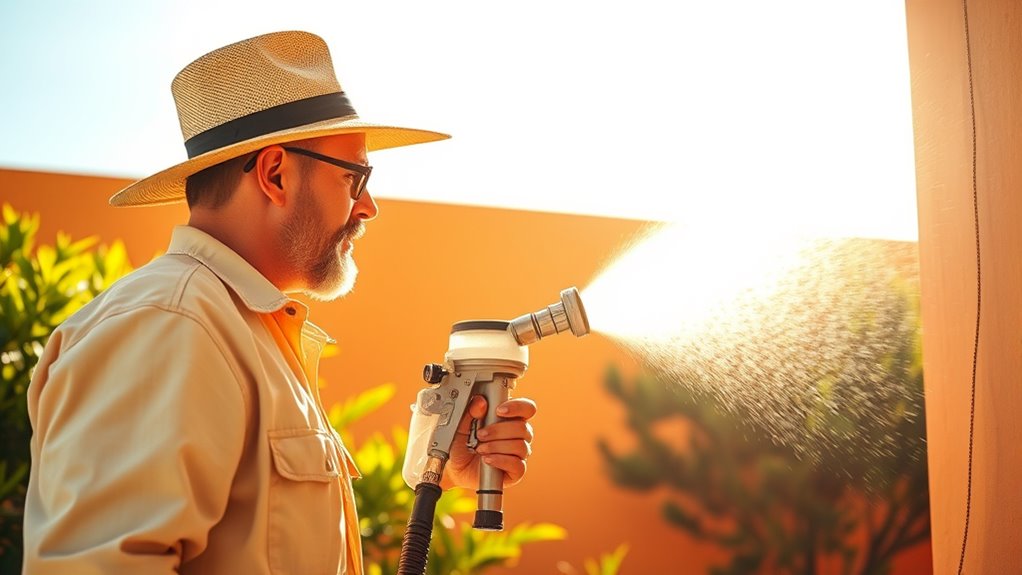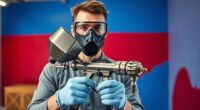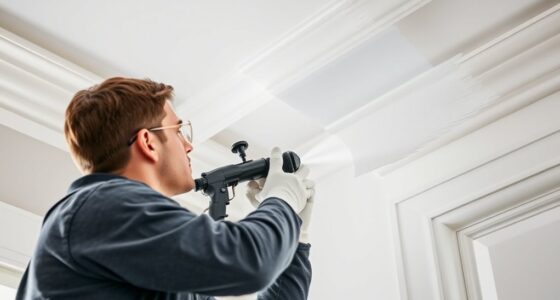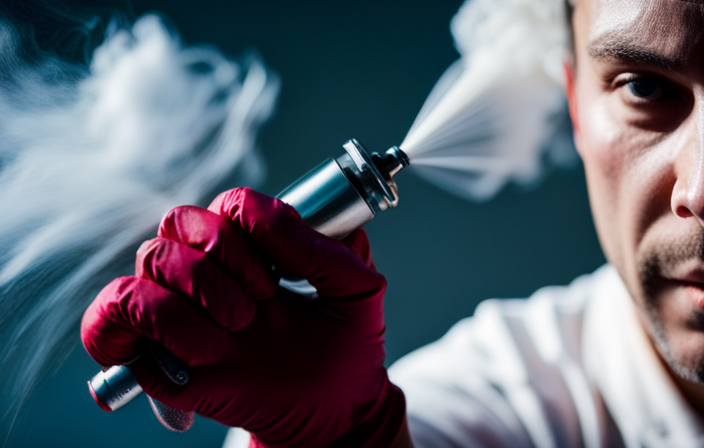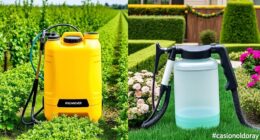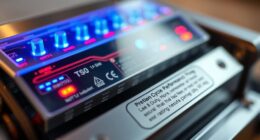When painting outdoors in hot weather with airless sprayers, it’s best to schedule your work during cooler parts of the day, like early mornings or late afternoons. Keep equipment and materials cool, and choose paints designed to resist rapid drying and heat. Adjust your spray settings for even coverage, and protect surfaces from direct sun and wind to slow drying. By following these tips, you’ll improve your results; discover more ways to master summer painting techniques.
Key Takeaways
- Schedule painting during cooler times like early mornings or late afternoons to prevent rapid drying and surface issues.
- Keep equipment and materials cooled and shaded to avoid heat-related malfunctions and ensure smooth operation.
- Use heat-resistant, slow-drying paints, and opt for lighter colors to reflect heat and enhance durability.
- Adjust sprayer settings with wider spray patterns and lower pressure for even coverage in hot conditions.
- Protect freshly painted surfaces from sun exposure and wind by shading or misting to promote proper curing.
Understanding How Heat Affects Airless Spraying
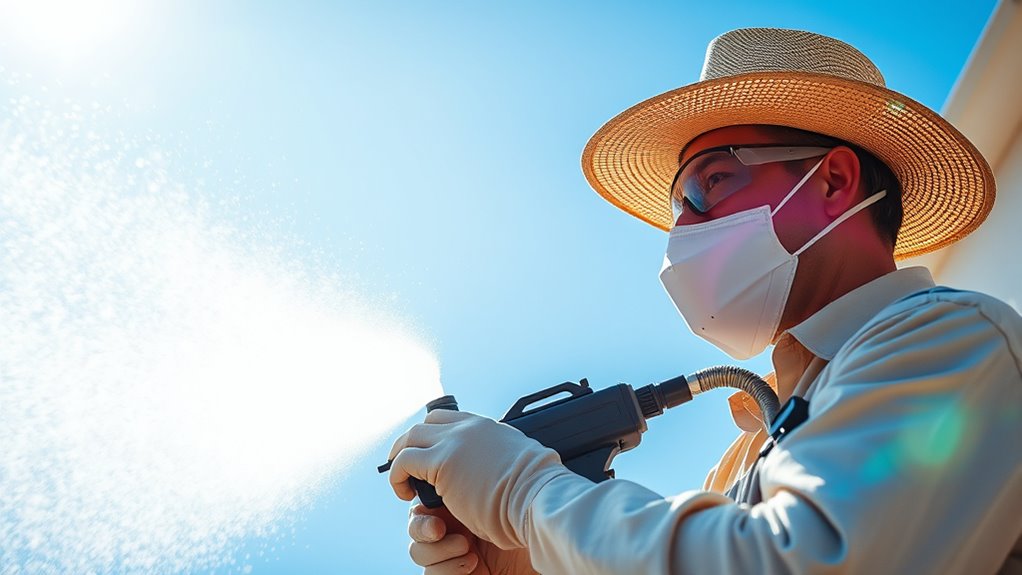
When temperatures rise during summer, heat can considerably impact how your airless sprayer performs. High temperatures cause the paint film to dry faster, which can lead to uneven coverage or sagging if applied too thickly. Additionally, heat promotes thermal expansion in the sprayer components, potentially causing leaks or misalignment. As the paint heats up, it becomes more prone to bubbling or blistering, affecting the finish’s durability. You might notice the paint film shrinking or cracking if it cools unevenly. To avoid these issues, it’s crucial to understand how heat influences the spray process. Keeping the equipment and materials cool and working in shaded areas helps maintain consistent spray quality and prevents problems associated with thermal expansion and rapid drying. Proper ventilation during spraying can also help dissipate heat and improve application results.
Choosing the Right Time of Day for Painting
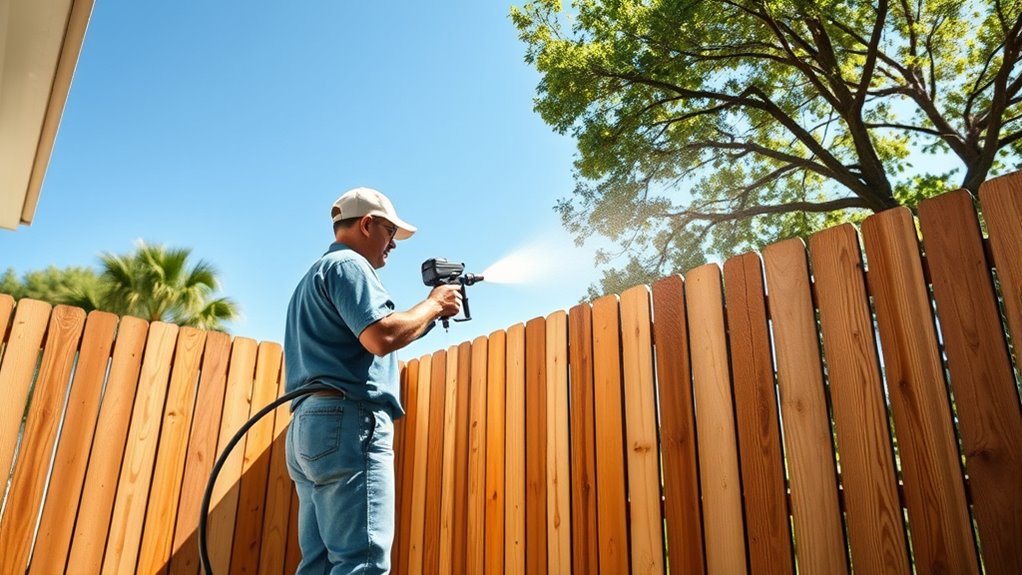
Choosing the right time of day for painting can profoundly influence your results, especially after understanding how heat affects airless spraying. Timing considerations are vital in hot weather, as environmental factors like sunlight, humidity, and temperature vary throughout the day. Early mornings or late afternoons often provide cooler, more stable conditions, reducing the risk of paint drying too quickly or uneven application. Avoid midday when the sun is strongest, and temperatures peak, which can cause paint to sputter or dry before proper adhesion. Monitoring weather forecasts helps you select ideal painting windows. Additionally, understanding how projector image quality can vary with environmental conditions underscores the importance of choosing optimal times for outdoor tasks. By considering these environmental factors and planning accordingly, you guarantee smoother application, better finish quality, and longer-lasting results. Choosing the right time ultimately helps you work efficiently and avoid common summer painting pitfalls.
Preparing Your Equipment for Hot Conditions
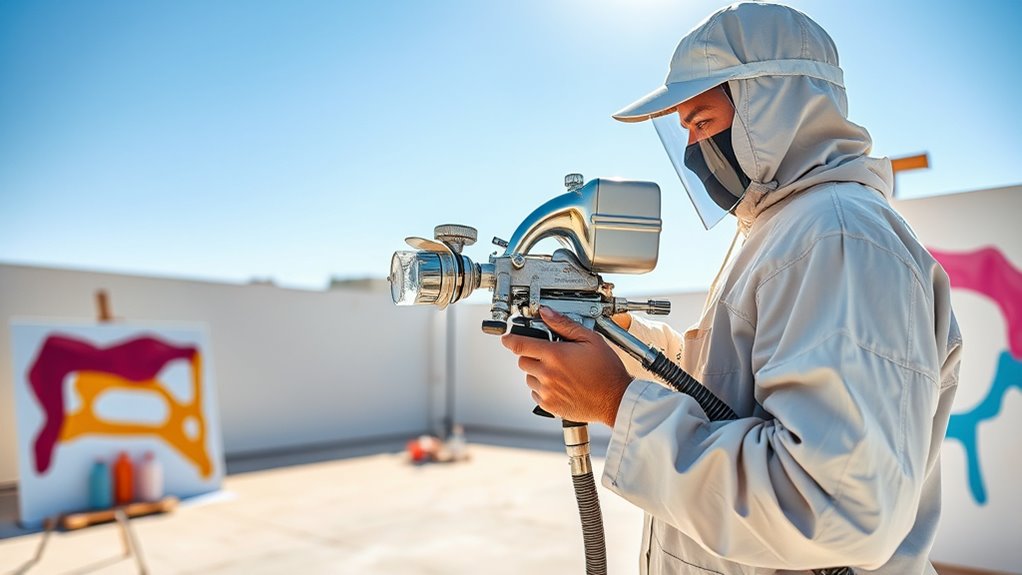
To guarantee your airless sprayer performs at its best in hot conditions, you need to prepare your equipment properly. Proper equipment maintenance ensures smooth operation and prevents overheating or malfunctions. Before starting, clean all parts thoroughly to remove paint residue and debris, which can clog the system. Check hoses, filters, and seals for wear or damage, replacing any worn components. Always follow safety precautions by inspecting electrical connections and ensuring proper ventilation. Additionally, store your equipment in a cool, shaded area when not in use to prevent heat damage. Regularly lubricate moving parts to reduce friction and overheating. Kia Tuning options can include performance upgrades that help your equipment handle high temperatures more effectively. By taking these steps, you’ll maintain excellent performance and reduce risks during hot weather painting.
Selecting Suitable Paints for Summer Application
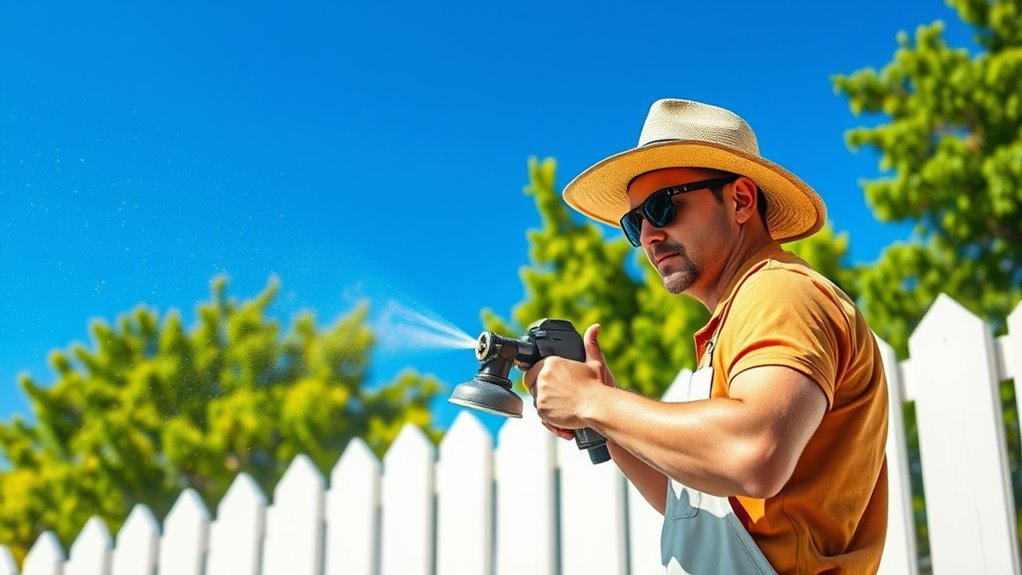
Selecting the right paints for summer application is essential to guarantee a smooth and durable finish in hot weather. Opt for paints with advanced formulations that resist heat and prevent quick drying, which can cause uneven coverage. When choosing paint color choices, lighter shades reflect sunlight, helping your project stay cool and last longer. Darker colors absorb heat, so use them sparingly in direct sunlight. Look for paints labeled for exterior or high-temperature use to ensure durability.
| Paint Color Choices | Paint Formulation |
|---|---|
| Light colors | Heat-reflective, UV-resistant |
| Dark colors | Use in shaded areas |
| Bright shades | Maintain color vibrancy over time |
| Neutral tones | Balance durability and appearance |
Adjusting Sprayer Settings for Optimal Results
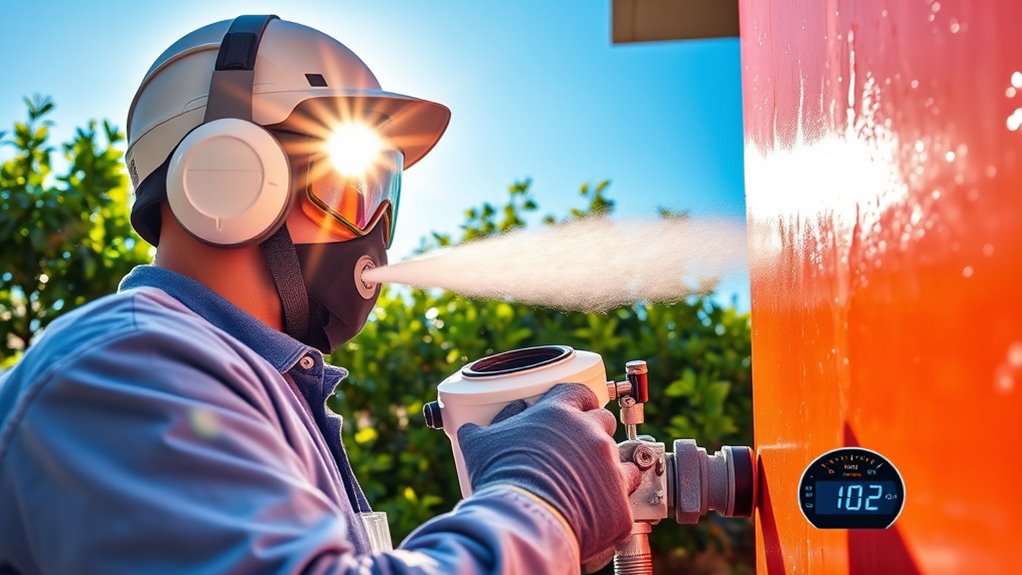
Adjusting your airless sprayer settings correctly is key to achieving a smooth, even coat and reducing overspray. Start by calibrating your sprayer to match the paint type and surface. Proper sprayer calibration ensures the right pressure and flow rate, preventing uneven coverage. Next, focus on nozzle selection; choose a nozzle size suited for summer conditions and the surface you’re painting. Larger nozzles deliver more paint but may cause drips if not adjusted properly. Check the spray pattern and adjust pressure accordingly for ideal atomization. Additionally, tweak the pressure settings to prevent overspray caused by high heat. Regularly test spray on a scrap surface to fine-tune your settings. These steps help you maintain control and achieve professional results in hot weather. Incorporating the right essential oils in your environment can also promote a more comfortable workspace by reducing stress and improving air quality.
Managing Paint Temperature and Storage

Properly managing your paint’s temperature and storage conditions can make a significant difference in achieving a smooth finish with your airless sprayer. Keeping paint within the recommended temperature range prevents issues like uneven spraying or poor adhesion. Store paint in a cool, dry place away from direct sunlight, and avoid letting it freeze or heat up excessively. Before painting, stir paint thoroughly to ensure consistent consistency. Use the table below to understand the importance of temperature management and paint storage:
| Storage Condition | Effect on Paint | Result on Finish |
|---|---|---|
| Cold, below 50°F | Thickens, slows flow | Uneven spray, drips |
| Hot, above 90°F | Skin formation, drying out | Poor adhesion |
| Properly cooled | Maintains consistency | Smooth, even finish |
Additionally, maintaining proper paint temperature helps optimize the application process and final appearance.
Techniques for Applying Paint in High Heat
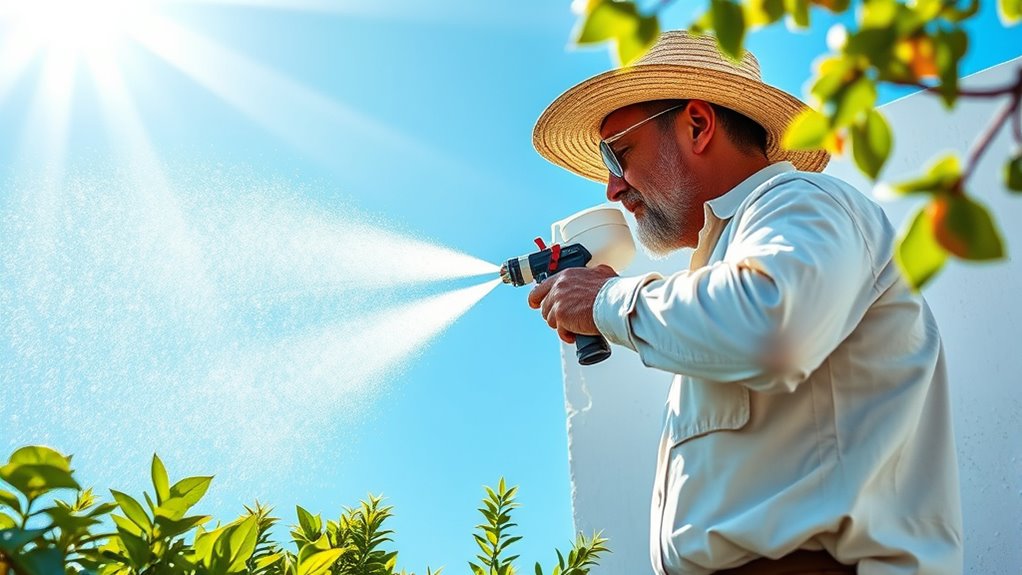
When applying paint in high heat, you should adjust your spray settings to prevent overspray and runs. Using cooling techniques, like misting the surface or working during cooler parts of the day, helps the paint dry properly. These steps make certain a smooth finish despite the challenging weather conditions. Additionally, understanding the best laundry detergents can help maintain the appearance of your tools and clothing used during painting projects.
Adjust Spray Settings
High heat can cause paint to dry too quickly, resulting in uneven coverage and poor adhesion. To combat this, you should modify your spray settings carefully. Start by selecting a wider spray pattern to ensure even application. Use a nozzle size that reduces pressure, helping control the spray and prevent overspray. Lowering the pressure also minimizes the risk of paint drying mid-air. Keep an eye on your spray pattern; a consistent, even pattern helps achieve smooth coats. Adjust the nozzle size if you notice uneven spray or drips. Regularly test your setup on a scrap surface before painting. Being mindful of paint drying times and adjusting accordingly can also improve results. These adjustments help maintain proper flow and coverage despite the heat, ensuring a durable, professional finish.
Use Cooling Techniques
To prevent paint from drying too quickly in high heat, you can use cooling techniques that help regulate the surface temperature and improve application quality. Using cooling fans or misting systems can be effective strategies. Cooling fans circulate air to keep surfaces cooler, reducing paint drying time. Misting systems spray a fine mist of water onto surfaces or the surrounding area, lowering surface temperatures without affecting paint adhesion. Consider the following options:
| Technique | Description | Benefits |
|---|---|---|
| Cooling Fans | Use fans to increase airflow | Evaporates heat, cools surface |
| Misting Systems | Spray water to reduce temperature | Maintains ideal drying conditions |
| Shade Cover | Provide shade during painting | Limits heat exposure |
| Timing | Paint early or late in the day | Avoids peak heat hours |
| Wet Surface | Keep surfaces damp before painting | Slows drying process |
Additionally, choosing the right paint type can help in hot weather, as some formulations are designed to withstand higher temperatures without compromising finish or adhesion.
Tips for Preventing Paint Drying Too Quickly
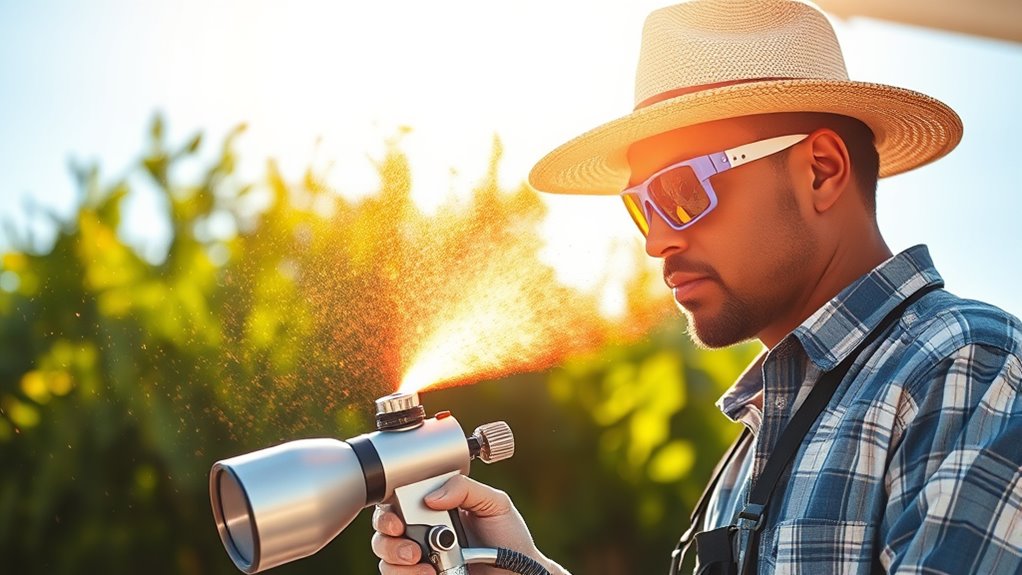
Paint can dry quickly when exposed to hot or windy conditions, which can lead to uneven coats and a compromised finish. This weather impact accelerates the paint drying process, making it harder to achieve a smooth, even application. To prevent this, work during cooler parts of the day, like early morning or late afternoon. Keep the surface moist by misting it lightly with water before painting. Use longer nap rollers or thicker brushes to help the paint stay wet longer. Also, consider adding a paint conditioner designed to slow drying time, giving you more control. Additionally, understanding how paint formulas behave under different weather conditions can help you select the best type for hot weather. – Work in shaded areas whenever possible – Use slower-drying paint formulations – Keep the surface damp with water – Avoid painting in direct sunlight or windy conditions
Protecting Your Work From Humidity and Sun Exposure
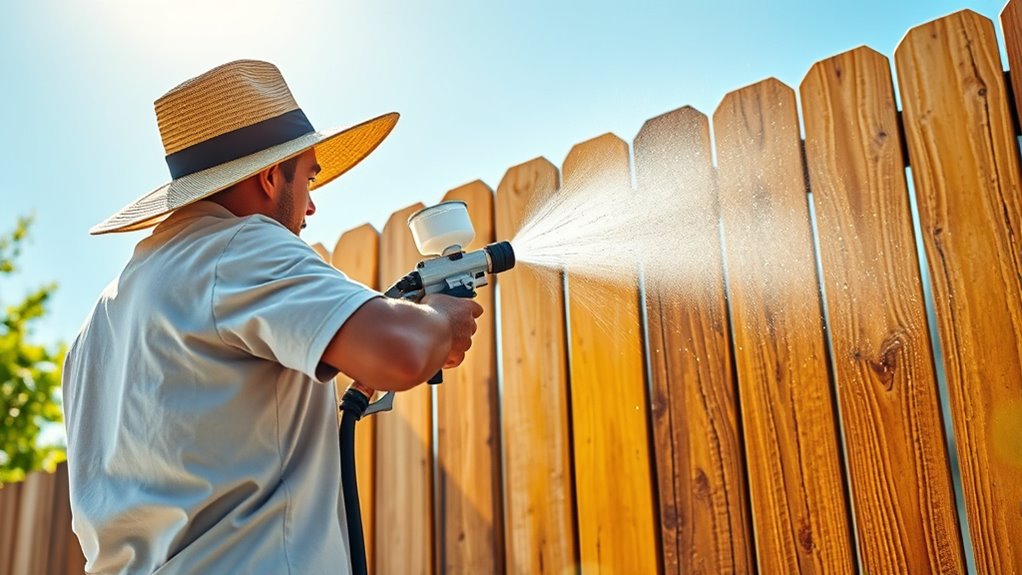
To guarantee your paint job lasts, you need to safeguard it from humidity and sun exposure. Shield your work from direct sunlight, control surface humidity, and consider applying protective coatings. These steps help your paint dry evenly and resist damage over time. Additionally, using quality paint products designed for hot weather can further enhance durability and performance.
Shield From Direct Sunlight
When working outdoors, direct sunlight can rapidly cause paint to dry too quickly or unevenly, compromising the finish. To prevent this, shield your work from direct sun exposure. Sunlight reflection off surfaces can intensify heat, speeding up drying times and risking uneven coats. Using shade structures like tents or tarps creates a barrier, reducing UV exposure and maintaining consistent drying conditions. Position your project to avoid the sun’s hottest hours, and consider setting up temporary shade during breaks. This approach helps control the environment, ensuring a smooth, professional finish. Always monitor how sunlight affects your work and adjust your shade structures accordingly. Proper planning and shading can also help prevent issues like paint bubbling, leading to a better final result. Staying protected from direct sunlight results in better adhesion, fewer imperfections, and a more durable paint job.
Control Surface Humidity
Humidity levels can substantially impact the quality of your paint job, especially when working outdoors. Surface moisture from dew, rain, or high ambient humidity can cause paint to improperly adhere or dry unevenly. Before painting, check the surface for any signs of moisture and allow it to dry thoroughly. If ambient humidity is high, wait for a more suitable time or consider scheduling your project during cooler, less humid hours. Keep in mind that high humidity can extend drying times and lead to surface issues like blistering or cloudiness. To protect your work, avoid painting in the early morning or late afternoon when humidity peaks. Managing surface moisture and monitoring ambient humidity helps ensure a smooth, durable finish. Additionally, understanding the impact of automation in business can help you better plan your project timeline around weather conditions.
Use Protective Coatings
Protective coatings are essential for shielding your paintwork from the damaging effects of humidity and sun exposure. Proper surface preparation is key to ensuring these coatings bond well and last longer. Before applying protective coatings, clean and dry the surface thoroughly, removing dirt, grease, and loose particles. Use high-quality, UV-resistant coatings designed for outdoor conditions to prevent fading and deterioration. Applying a primer can enhance adhesion and provide a better base for the protective layer. Keep in mind that the right protective coatings act as a barrier against moisture and UV rays, extending your paint’s lifespan. Security measures such as surveillance cameras and motion detectors can additionally help protect your property from damage or theft during the painting process. Regularly inspect and reapply as needed
Post-Painting Care and Curing in Warm Weather
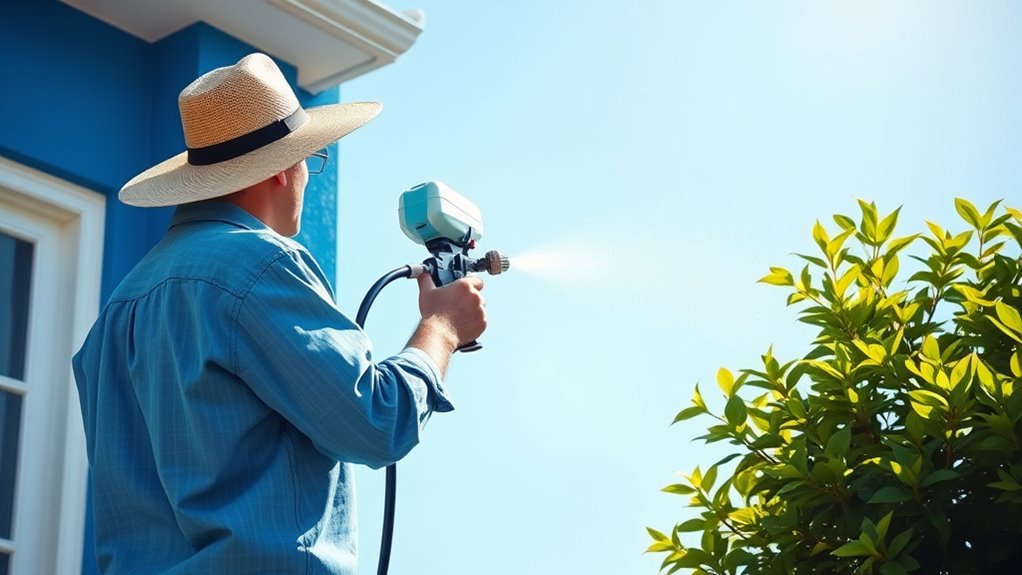
After completing your painting project in warm weather, it’s essential to give the fresh coating proper care to guarantee ideal curing. First, ensure the paint adheres well by avoiding rapid drying, which can cause cracking. Proper surface preparation is critical—remove dust, dirt, and grease to enhance paint adhesion. Keep the painted surface protected from direct sunlight and high temperatures, as heat can slow curing or cause uneven drying. Maintain consistent moisture levels by lightly misting the surface if needed, especially during hot days. Avoid touching or cleaning the area prematurely, as this can damage the finish. Additionally, using a humidifier or dehumidifier can help regulate moisture levels in the environment, promoting even curing and reducing the risk of issues caused by temperature fluctuations. By following these steps, you’ll promote even curing and a durable, flawless finish that withstands the summer heat.
Frequently Asked Questions
How Can I Prevent Paint From Bubbling in Hot Weather?
To prevent paint from bubbling, you need to guarantee good paint adhesion and proper surface preparation. Clean the surface thoroughly and remove any dirt or loose paint. Use a high-quality primer if needed. Apply paint in cool, dry conditions, avoiding direct sunlight. Maintain consistent spray pressure and avoid over-application. These steps help the paint adhere better and reduce the risk of bubbling, especially when it’s hot outside.
What Safety Precautions Should I Take When Painting in High Temperatures?
When painting in high temperatures, you should prioritize safety by wearing protective gear like gloves, goggles, and masks to avoid fumes and splashes. Confirm proper ventilation, opening windows and doors to disperse fumes and prevent inhalation hazards. Take frequent breaks in shaded areas, stay hydrated, and avoid painting during the hottest parts of the day. These precautions help keep you safe while achieving quality results in hot weather.
Can I Use Any Type of Paint During Summer Heat?
You might wonder if any paint works during summer heat, but it’s best to evaluate paint compatibility and weather considerations. Not all paints perform well in high temperatures; some may dry too quickly or crack. Use paints formulated for hot weather and check manufacturer guidelines. This ensures your project looks great and lasts, even under the sun’s intense heat. Always select the right paint for summer conditions to achieve ideal results.
How Do I Avoid Uneven Spray Patterns in Hot Conditions?
Think of smooth application as a dance—you need to stay in rhythm. To avoid uneven spray patterns, make sure your spray nozzle calibration is precise and check for wear. Adjust paint viscosity if it’s too thick, as this can cause sputtering. Keep your spray distance consistent and work in steady, overlapping passes. These steps help maintain an even spray, even when the heat tries to throw off your rhythm.
What’s the Best Way to Clean Equipment After Summer Painting?
After summer painting, you should clean your equipment thoroughly to guarantee proper maintenance. Rinse the spray gun, hoses, and filters with the appropriate solvent, like water or paint thinner, depending on the paint used. This not only prolongs your equipment’s life but also considers environmental factors by disposing of waste responsibly. Regular cleaning prevents clogs and ensures peak performance for your next project.
Conclusion
Painting in hot weather can be challenging, but with the right tips, you’ll achieve a smooth, durable finish. Did you know that paint can dry up to 50% faster in temperatures above 85°F? By timing your project wisely and adjusting your techniques, you’ll avoid common pitfalls like peeling or uneven coverage. Stay patient, protect your work from the sun, and enjoy the process—you’ll be proud of your summer painting success!
